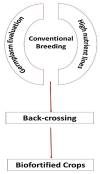Biofortification-A Frontier Novel Approach to Enrich Micronutrients in Field Crops to Encounter the Nutritional Security
- PMID: 35209127
- PMCID: PMC8877941
- DOI: 10.3390/molecules27041340
Biofortification-A Frontier Novel Approach to Enrich Micronutrients in Field Crops to Encounter the Nutritional Security
Abstract
Globally, many developing countries are facing silent epidemics of nutritional deficiencies in human beings and animals. The lack of diversity in diet, i.e., cereal-based crops deficient in mineral nutrients is an additional threat to nutritional quality. The present review accounts for the significance of biofortification as a process to enhance the productivity of crops and also an agricultural solution to address the issues of nutritional security. In this endeavor, different innovative and specific biofortification approaches have been discussed for nutrient enrichment of field crops including cereals, pulses, oilseeds and fodder crops. The agronomic approach increases the micronutrient density in crops with soil and foliar application of fertilizers including amendments. The biofortification through conventional breeding approach includes the selection of efficient genotypes, practicing crossing of plants with desirable nutritional traits without sacrificing agricultural and economic productivity. However, the transgenic/biotechnological approach involves the synthesis of transgenes for micronutrient re-translocation between tissues to enhance their bioavailability. Soil microorganisms enhance nutrient content in the rhizosphere through diverse mechanisms such as synthesis, mobilization, transformations and siderophore production which accumulate more minerals in plants. Different sources of micronutrients viz. mineral solutions, chelates and nanoparticles play a pivotal role in the process of biofortification as it regulates the absorption rates and mechanisms in plants. Apart from the quality parameters, biofortification also improved the crop yield to alleviate hidden hunger thus proving to be a sustainable and cost-effective approach. Thus, this review article conveys a message for researchers about the adequate potential of biofortification to increase crop productivity and nourish the crop with additional nutrient content to provide food security and nutritional quality to humans and livestock.
Keywords: agronomic biofortification; gene modification; green technology; mineral dense field crops; nanotechnology; transgenic/biotechnological approach.
Conflict of interest statement
The authors declare no conflict of interest.
Figures





References
-
- Maertens M., Velde K.V. Contract-farming in staple food chains: The case of rice in Benin. World Dev. 2017;95:73–87. doi: 10.1016/j.worlddev.2017.02.011. - DOI
-
- Klikocka H., Marks M. Sulphur and nitrogen fertilization as a potential means of agronomic biofortification to improve the content and uptake of microelements in spring wheat grain DM. J. Chem. 2018;2018:9326820. doi: 10.1155/2018/9326820. - DOI
Publication types
MeSH terms
Substances
Grants and funding
LinkOut - more resources
Full Text Sources
Other Literature Sources

